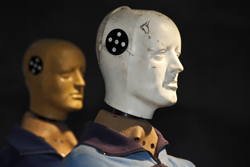Crash-test dummies are getting smarter
One of the EU's top priorities is to reduce casualties resulting from over a million road accidents each year. Such accidents amount to EUR 130 million annually. To address this kind of road carnage worldwide, car manufacturers have initiated the 'Global human body model' (GHBM) project as a joint effort between research, testing, regulation and information dissemination. The EU-funded project 'Development of a finite element model of the human thorax and upper extremities' (THOMO) has contributed to the international effort by developing a numerical model of the human thorax. The thorax is the part of the body between the head and abdomen. The model was created using over a hundred sensors on each of 18 post-mortem humans to fully map the geometry of the thorax. To define the material properties of the model, the THOMO team performed various tensile and stress tests. Their results have defined new 'biofidelity' targets for crash-test dummies. In other words, knowing how bodies of different shapes and sizes respond to impact can help to create crash-test dummies that are realistic and representative of different populations. This research will not just be useful in road safety. Another of the programme's goals is to halve the number of rail fatalities by 2020. In the meantime, the team is working on optimising the system to use geometry and soft tissue impact data to personalise the models even further.







